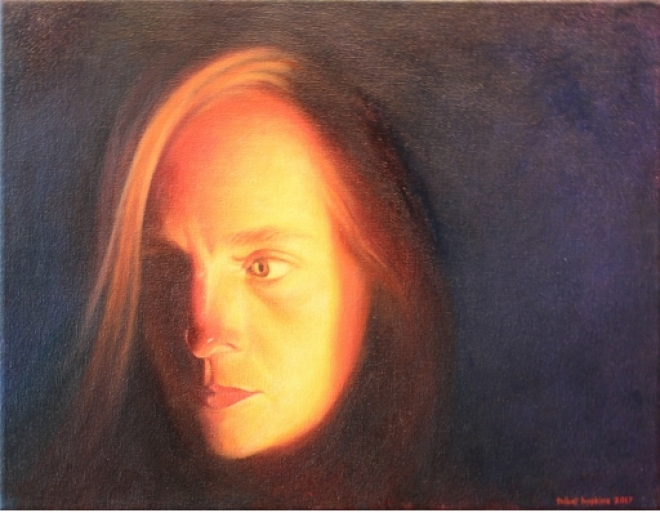Embracing Art

Widening our taste and vision with Critical Mass 5
There is a lushly rendered painting of a shaman by Marilyn Couch and an exquisitely detailed sculptural head by Mark Burt. There is Talbot Hopkins’ pensive self-portrait, her face strikingly illuminated by firelight. Kedrick Williams has made a portrait of the iconoclastic recording artist Frank Ocean, drolly titled “St. Francis,” which turns him into a kind of icon in a religious style, a gilded sphere encircling his head in the painting. Such is the formal and visual variety of the current Critical Mass 5 exhibition at artspace in downtown Shreveport.
Audiences and participating artists have come to expect this kind of eclecticism from the annual Critical Mass exhibitions. No single art show can hope to fully represent the breadth and depth of a dynamic artist community, of course – and a community that encompasses Shreveport and its surrounding communities is no exception. But the Critical Mass exhibitions have become a welcome barometer of the variety and substance of the art being produced here.
From the exhibited works – one each by 130 artists in Critical Mass 5 – the critic is charged with choosing a “Best in Show,” and this is an invariably difficult process. But it is also a pleasurable one, reminding us just how much an artist can convey in a single example.
Happily, artists who won in years past continue to look strong in Critical Mass 5. The woman in Rachel Stuart-Haas’ “Capricorn,” for example, has the same electric presence as in her winning picture from 2011. The cast of figures in Joshua Chambers’ “All the While Working Himself Tighter into Life’s Snare,” such as a chimp and a man in diver’s suit, have lost none of their absurd but revealing relationship to everyday reality, as when they were singled out in 2013. Then there has been the pleasure of seeing each of the winning artists (thus far) get a subsequent solo exhibition at artspace, as an extension of the award process. (For the record, the others have been Taffie Garsee, Marilyn Couch and Devin Rachul McClintic.)
In this difficult process of choosing one work as the “best in show,” one way of knowing, as a critic, that you have fixed on the right work is the amount of times you return to it while viewing the show closely. This was how I ultimately picked Hopkins’ small painting, “In and Out of the Fire,” a small self-portrait that is powerful for the way it presents the artist’s radiantly lit face within it, surrounded by darkened space.
The picture creates a kind of visual force field, as wholly successful art often does, and its visual power hints at the sort of emotional intensity and personal struggle that is conveyed by its title.
Yet before one makes enough return trips to a painting like Hopkins,’ there are involving encounters with other engrossing works. For its keen eye on a common ritual in “Family Reunion,” Julie Crews’ painting is persuasive. The people become everymen and everywomen, cropped as they are to keep their faces out of the picture. She takes such pleasure in rendering creased pants and striped tops – and Crews has the skill with a brush and with her sharp eye for color to make it all look seductive. The head in Mark Burts’ “Old Mandrake – My Friend Gary,” meticulously done in felted wool and containing teddy bear eyes, is unreal in physiognomy but believable, like a being from a compelling science fiction or fantasy tale. And for an intricate sculptural meditation on the nature of existence, Bennett Sewell’s creature in “What’s the Meaning of It All?” akin to a cross between a big fish, a giant insect and an extra-terrestrial, insists on not being ignored; it integrates your image, too, in a mirrored surface that also contains the words in its title.
The point, with an exhibition like this, is to enjoy works in styles and with approaches that you generally do, but also to challenge yourself to embrace works that expand that sphere of enjoyment. The breadth of Critical Mass 5 is expansive enough to coax all of us to widen the parameters of our taste and vision as viewers.
Robert L. Pincus served as the art critic of The San Diego Union and The San Diego Union-Tribune for 25 years, beginning in 1985. Prior to that he spent four years as art critic for the Los Angeles Times. He has a combined doctorate in English and art history from the University of Southern California and is the author of “On a Scale That Competes with the World,” a book on the work of artists Edward Kienholz and Nancy Reddin Kienholz.
